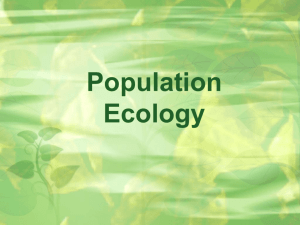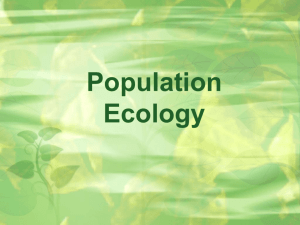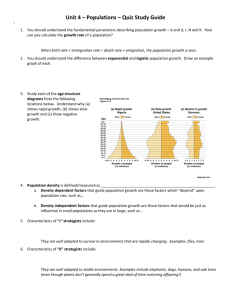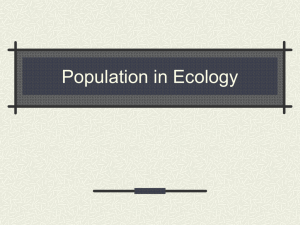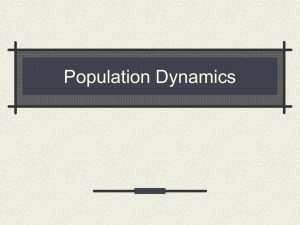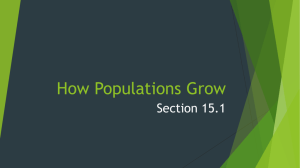Population Ecology: Dynamics, Growth & Strategies
advertisement
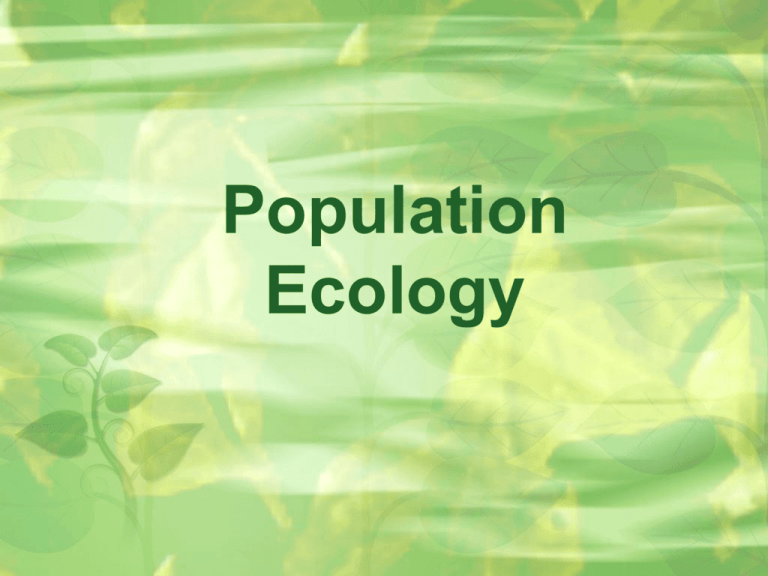
Population Ecology Population Dynamics • Population: • All the individuals of a species that live together in an area • Demography: • The statistical study of populations, allows predictions to be made about how a population will change Population Dynamics • Three Key Features of Populations • Size • Density • Dispersion Three Key Features of Populations Size: number of individuals in an area Three Key Features of Populations • Growth Rate: • Birth Rate (natality) - Death Rate (mortality) • How many individuals are born vs. how many die • Birth rate (b) − death rate (d) = rate of natural increase (r) Three Key Features of Populations Density: measurement of population per unit area or unit volume Pop. Density = # of individuals ÷ unit of space How Do You Affect Density? 1. Immigration: movement of individuals into a population 2. Emigration: movement of individuals out of a population 3. Density-dependent factors: Biotic factors in the environment that have an increasing effect as population size increases (disease, competition, parasites) 4. Density-independent factors: Abiotic factors in the environment that affect populations regardless of their density (temperature, weather) Factors That Affect Future Population Growth Immigration Natality + + Population Emigration - Mortality Population Dispersion Three Key Features of Populations • Dispersion: describes the spacing of organisms relative to each other • Clumped • Uniform • Random How Are Populations Measured? • Population density = number of individuals in a given area or volume • Count all the individuals in a population • Estimate by sampling • Mark-Recapture Method How Do Populations Grow? • Idealized models describe two kinds of population growth: 1. Exponential Growth 2. Logistic Growth Carrying Capacity • Carrying Capacity (k): • The maximum population size that can be supported by the available resources • There can only be as many organisms as the environmental resources can support Exponential Growth Curve Figure 35.3A Logistic Growth Curve Factors Limiting Growth Rate • Declining birth rate or increasing death rate are caused by several factors including: • Limited food supply • The buildup of toxic wastes • Increased disease • Predation “Booms” and “Busts” Reproductive Strategies • R Strategists Short life span Small body size Reproduce quickly Have many young Little parental care Ex: cockroaches, weeds, bacteria Reproductive Strategies • K Strategists Long life span Large body size Reproduce slowly Have few young Provides parental care Ex: humans, elephants Age Distribution • Distribution of males and females in each age group of a population • Used to predict future population growth Human Population Growth • J curve growth • Grows at a rate of about 80 million yearly • r =1.3% • Why doesn’t environmental resistance take effect? • Altering their environment • Technological advances • The cultural revolution • The agricultural revolution • The industrial-medical revolution The Human Population • Doubled three times in the last three centuries • About 6.1 billion and may reach 9.3 billion by the year 2050 • Improved health and technology have lowered death rates History of the Human Population
